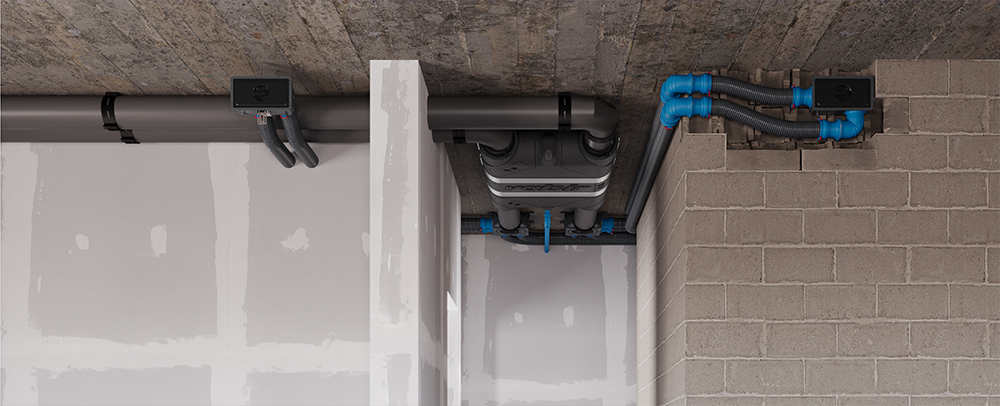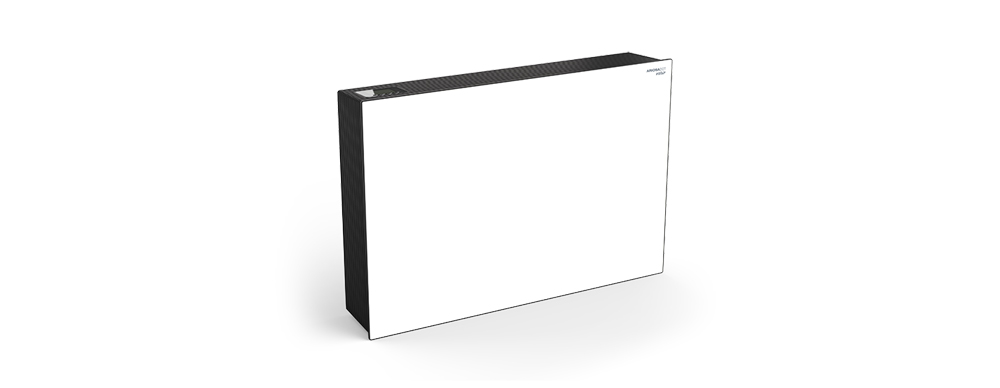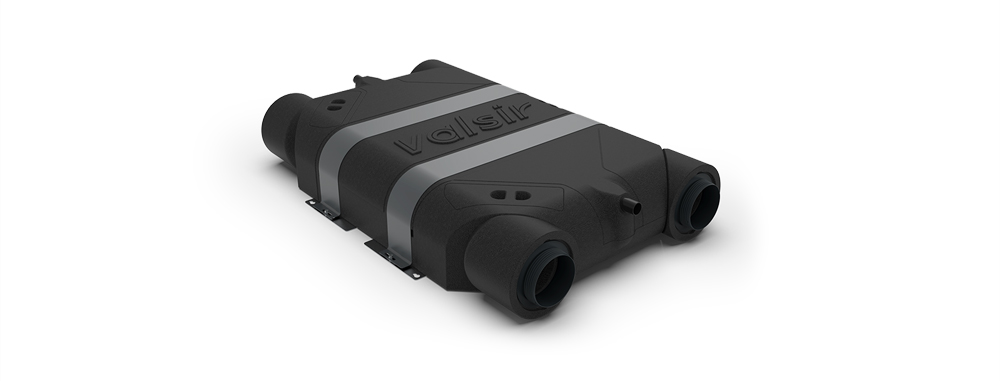Breathing clean air is essential: indoor air quality can directly affect health, concentration and even sleep quality. HRV meets this need by constantly renewing the air without the need to open windows and without heat loss.
What is decentralised HRV?
Decentralised HRV is a decentralised solution designed for air treatment in individual rooms. These are autonomous units that are installed directly on the perimeter walls and guarantee air exchange, filtration and localised heat recovery. A decentralised solution is particularly suitable for homes where it is not possible or convenient to install a centralised system.
Its simple installation, requiring only one or two holes in the wall and an electrical connection, makes it ideal for small flats, offices and rooms prone to humidity. In addition, each machine can be used independently or in combination with other units to cover larger areas.
What is a centralised HRV?
Centralised HRV is a more structured system that serves several rooms at the same time through a network of ducts. The heart of the system is a central ventilation unit equipped with a heat recovery unit and filters, from which ducts reach every room.
This type of system is generally installed during construction or major renovations, as it requires building work and dedicated space in ceilings or false ceilings (or in special cabinets or technical shafts). In return, it offers uniform air quality control throughout the home, with automatic flow management and high thermal efficiency.

Ariosa DOT: an example of a new generation decentralised HRV
Ariosa DOT is one of the most advanced solutions in the decentralised HRV category. Unlike many models on the market that operate with alternating flow, Ariosa DOT is a dual cross-flow machine with heat recovery, available with a sensible or enthalpy exchanger.
It is available in 3 different versions:
- Ariosa DOT: the basic version, suitable for all rooms up to 70 square metres
- Ariosa DOT HP: equipped with a refrigeration circuit for dehumidification, ideal in hotter and more humid areas
- Ariosa DOTmini: the most compact solution, which uses a single hole to the outside for air intake and extraction
It is extremely quiet, controllable via app, and also suitable for particularly sensitive environments such as bedrooms, thanks to its high-efficiency filters (ISO Coarse and ISO ePM).

Ariosa HV: the centralised HRV
Ariosa HV is our solution for centralised ventilation in residential settings. Available in 170, 250 and 330 m³/h versions, it can be installed on the ceiling or wall, even in small spaces thanks to its slim design (21 cm).
The unit is equipped with constant flow electronic fans, a high-efficiency heat recovery unit (sensitive or enthalpy), automatic bypass and Wi-Fi interface. It can be controlled via app or remote LCD panel and is home automation ready thanks to the Modbus interface.
With its 5 temperature and humidity sensors, Ariosa HV ensures large air quality throughout the home while optimising energy consumption.

Comparison between decentralised and centralised HRV
From a technical point of view, the main differences concern energy efficiency, maintenance and surface area covered. Both solutions can achieve recovery efficiencies of over 90% thanks to enthalpy or sensitive heat exchangers.
Centralised HRVs such as Ariosa HV allow uniform and centralised management, with optimised energy costs in the long term. However, they require more structured maintenance. Decentralised HRVs such as Ariosa DOT, on the other hand, are easier to manage and offer modularity, but are more suitable for smaller spaces.
Advantages of decentralised HRV
One of the main strengths of decentralised HRV is its ease of installation: no ducting or complex building work is required. It can be installed in a few hours, even in occupied spaces, and the unit blends in perfectly with the surroundings.
It is ideal for targeted interventions in cases of mould or condensation and for those who want to improve air quality without undergoing renovation. In addition, the initial cost is lower than that of a centralised system.
Advantages of centralised HRV
Centralised HRV guarantees total control over the entire home. It is ideal for new buildings or complete renovations, where the ductwork can be installed in advance.
In the long term, it offers better energy balance and optimised comfort management, thanks to features such as automatic bypass and connection to home automation systems. The aesthetics of the rooms remain clean, with fewer visible components.

When to choose decentralised mechanical ventilation
Decentralised HRV is ideal for small flats, such as studio or one-bedroom flats, or for individual rooms such as bathrooms, kitchens or bedrooms. It is also the perfect solution for quick interventions, when you want to act locally on problems such as mould or stale air.
When to choose centralised mechanical ventilation
Centralised HRV is suitable for medium and large homes, villas or flats spread over several floors. It is particularly recommended in new buildings or in cases where maximum energy efficiency and overall comfort are required.
In addition to Ariosa HV, we also mention the Ariosa V model, designed for vertical installation and available in sizes of 350, 450 and 600 m³/h, to cover even larger areas with installation flexibility.
There is no one type of system that is inherently better or worse than another. The choice depends on practical factors, the space available, personal requirements and how we use the space. However, it remains essential to adopt a solution that guarantees good air quality in the environments where we spend most of our time!
Ariosa DOTmini: the ultra-compact solution
Ariosa DOTmini represents a further evolution of decentralised HRV: compact, discreet and high-performance. It has a single connection to the outside, through which it manages both air intake and extraction, reducing visual impact and simplifying installation.
Ideal for small, confined spaces, technical rooms or in all those contexts where space is limited and the intervention must be as discreet as possible.
Dehumidification and comfort: the added value of Ariosa DOT HP
The Ariosa DOT HP model integrates a refrigeration circuit powered by R290 gas with zero environmental impact. This allows the dehumidification of the incoming air, making it particularly effective in the summer months or in environments subject to high humidity.
Thanks to integrated sensors, the function is activated automatically when certain thermo-hygrometric values are exceeded, contributing to constant comfort throughout the year.

Installation, maintenance and health
Decentralised HRV systems require quick and non-invasive installation, while centralised systems require more careful design and longer installation times. In terms of maintenance, both require periodic cleaning and replacement of filters, an operation simplified by a smart notification system that signals when intervention is required.
From a health point of view, both solutions use high-performance filters that remove PM10 and PM2.5 particulates, viruses, bacteria, pollen and allergens. This is a huge benefit for allergy sufferers and people with respiratory problems.
An informed choice
Choosing between decentralised and centralised mechanical ventilation depends on various factors: the size of the property, the possibility of intervention, the available budget, and comfort and health requirements.
Those looking for a flexible, economical and local solution can opt for decentralised HRV, such as Ariosa DOT or Ariosa DOTmini. For those who want centralised management and superior performance, Ariosa HV or Ariosa V are the ideal choice, especially in new buildings.
Whatever you choose, HRV guarantees a healthier home, cleaner air and greater comfort, every day of the year.
 Italiano
Italiano
 English
English
 Deutsch
Deutsch
 Français
Français
 Español
Español
 Greek
Greek